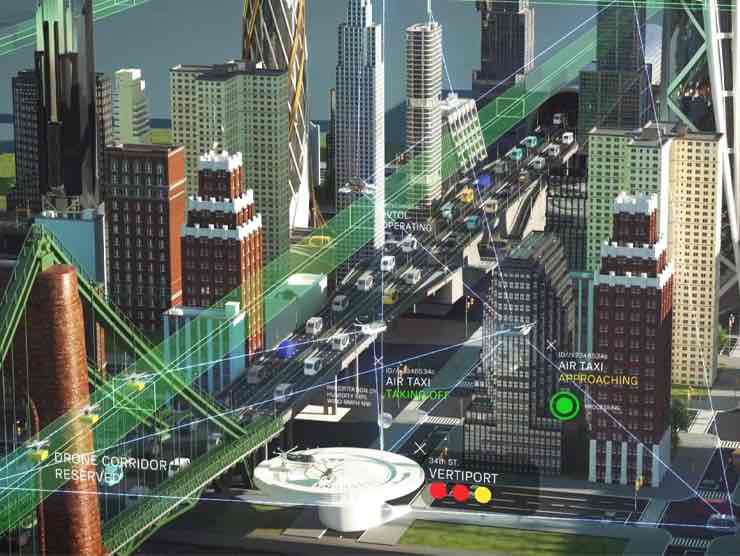We met Kenneth Freeman and Supreet Kaur from NASA Ames Research Center in Mountain View, California (USA). Kenneth Freeman is the Principal Investigator for the Data & Reasoning Fabric (DRF) project and Lead Secure Airspace Technology Group. Supreet Kaur is the Lead Systems Engineer for the Data & Reasoning Fabric (DRF) project based out of NASA Ames Research Center in Silicon Valley.
DRF is envisioned to enable the growth of future flight by enabling an ecosystem of data and AI-based decision support tools (reasoning) to enable the transportation of people and cargo to places previously not served or underserved by aviation.
NASA’s Data & Reasoning Fabric (DRF) project will help air mobility, to move people and cargo in the city. How will the intertwined “fabric” of intelligence that sends aircraft specific tailored information for aircraft work?
The Data and Reasoning Fabric (DRF) is a digital ecosystem built on an open and decentralized platform which enables exchange and interplay between many complex systems and end-users, including government and industry stakeholders. DRF provides access to a catalogue of “data services”, consisting of diverse and dynamic datasets, as well as “reasoning services”, which is data converted into meaningful information utilizing Artificial Intelligence (AI) based decision-making support. The digital “fabric” is an interwoven layer of those data and reasoning services.
The beauty of DRF is the tailoring of information – based on your needs. Imagine a scenario in which a drone operator wants to make a delivery from point A to point B. Well off the bat you know the needs of a drone operator are different than the needs of a pilot of a passenger aircraft. Because when people are involved, you have more variables to consider for human safety. Now let’s think about the types of information the drone operator will need for that mission. They need to know the origin and destination, including the takeoff and landing protocol of those coordinates. They need to know if there are any no-fly zones they need to avoid. They need information about the traffic in the airspace they will fly through. And also, weather patterns they can expect. All of these are different datasets, and they’re dynamic because the environment is always changing. But with DRF you have autonomy over the information you want to see, you can tailor it for your needs and your missions. And it is available in one place.
Credits: NASA / Aeronautics Research Mission Directorate (ARMD) / Transformative Aeronautics Concepts Program (TACP) / Convergent Aeronautics Solution (CAS) Project
Many people are already familiar with what a reasoning service is. When you pull up a navigation app on your phone you have access to different kinds of data relevant to you – maps, accident reports, traffic conditions, roadwork status, and so on. The machine learning algorithm behind the app sorts through this data and tells the driver the best route. In the DRF ecosystem, a trajectory service provides a similar guidance, but for a 3-dimensional airspace with more datasets in consideration; altitude, drone battery health or fuel reserves in an aircraft, local weather conditions, emergency alerts, locations of nearby aircrafts, etc.
Will every person who lives in town must have a navigation app on its smartphone? Will this app communicate us any accidents or any weather problems?
DRF is about connecting people to the tools and resources they need to make timely decisions. If you look at the current avionics systems, that information is married to a piece of hardware, with all the data originating from one source. You don’t get much of a choice, DRF is envisioned to be a hardware agnostic solution – which means it should enable access to the data an end user needs, without having to purchase a special avionic systems or hardware for it. DRF will have the ability to connect vehicles, airspace, cities, infrastructure, and data and reasoning services in a single ecosystem. Third-party vendors will be able to develop services, or smartphone ready apps, to provide information within this ecosystem. For example, information on weather, accidents, emergency alerts or aircraft delays can be incorporated into a DRF-enabled ecosystem.

Credit: NASA
In your opinion, could future’s hackers breach the system and send false information to aircrafts?
There is always a risk of cybersecurity threats, impacting any technological system including the possibility of future hackers breaching the system and sending false information to aircraft. While the risk of cyber-attacks cannot be completely eliminated, it is important to recognize that the aviation industry is actively working to address these risks and implement measures to protect against potential threats. The interconnected nature of a data and decision support ecosystem enabled by DRF means that it is important to implement robust security measures to protect against potential cyber-attacks. This includes measures such as user authentication, data authorization methods, encryption of data, firewalls, intrusion detection systems, and regular security updates.
What are the most important advantages of DRF Project? Will there be also the Autopilot and Full Self-Driving?
DRF is an information infrastructure that helps assemble useful data and reasoning services to provide in-time information to autonomous aircrafts and operators for decision making. The intent is to form a connected, interwoven “fabric” of intelligence that sends specific, tailored, and relevant information, to the end-users, wherever they are. Down the line, the DRF infrastructure would enable the vision of a “smart” city and airspace. When we think about on-demand air transportation of people and cargo, that vision includes capabilities such as air-taxis and autonomous drones. While this project is focused on future autonomous systems, DRF could even be applied to traditional transportation systems in practice today, increasing the capacity and situational awareness while increasing efficiency and safety of operations. The intent of DRF is to provide flying vehicles the capabilities to go to places that are typically not available, while serving people who previous did not have access to these means of transportation.


Update to one of your published releases. Please publish news of our good work. Thank you.